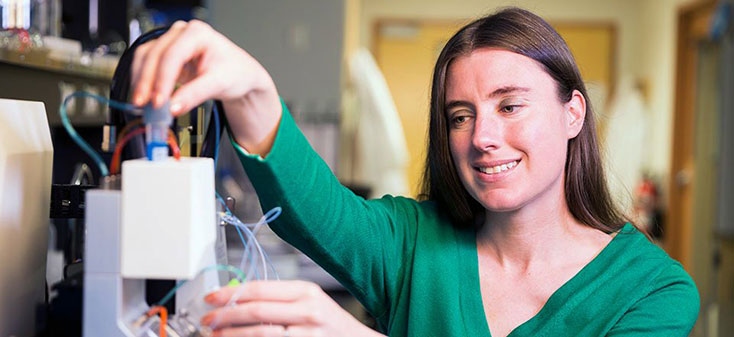
Dr. Stephanie Willerth: Regenerative Medicine and collaborations with StarFish Medical
Dr. Stephanie Willerth is the Acting Director of the Biomedical Engineering program and the Centre for Biomedical Research at the University of Victoria, and Member of the International Collaboration on Repair Discoveries (ICORD). We spoke recently about her current research in Regenerative Medicine and collaborations with StarFish Medical.
Nick Allan: Please tell us about the University of Victoria’s Willerth Lab and your current projects.
Stephanie Willerth: My lab focuses on engineering neural tissue using a variety of strategies. Some of these strategies include bio printing neural tissues using stem cells. In particular, we use a highly advanced bioprinter from the local Vancouver biotech start-up, Aspect Biosystems. It’s really cool because we can print tissue similar to that of the brain and spinal cord derived from human cells. These could be potentially used as a tool for drug screening. We also have another project where we directly reprogram somatic cells, like skin cells, and turn them into tissues similar to that found in your brain.
Nick Allan: How’s it going?
Stephanie Willerth: It’s been going quite well. Our lab has had a really productive year and we’ve had a number of papers come out, including some that are open access, about our 3D bio printing work as well as our direct reprogramming work.
Here are some links to our recent work:
Nick Allan: In addition to the open access papers, what are the reactions from colleagues in the industry?
Stephanie Willerth: Industry and colleagues have been very excited about our work for different reasons. We have successfully been able to develop a bioink, which is the material you use to deliver your cells when bioprinting. In the 3D bio printing process, you use a mixture of these bioinks and cells to fabricate essentially living human tissues. This novel bioink supports stem cell growth and differentiation at levels that haven’t been seen before. There’s a lot of excitement both from our colleagues and from industry about using this bioink as a tool to make a variety of tissues in addition to our mini brains and spinal cords
Nick Allan: I heard you say “mini brain.” What’s a mini brain?
Stephanie Willerth: When you’re growing tissues in a dish they’re often limited by the nutrients and oxygen that can be delivered to your tissues, so they aren’t full scale brains. But they can replicate several of the brain features in a miniature scale. So you can see the cells talking to each other like they would in a brain.
Nick Allan: Well that’s fantastic. But surely not something like a hippocampus?
Stephanie Willerth: Some people do generate mini tissues called organoids where they do recreate the structure of the hippocampus and other regions of the brain.
Nick Allan: What StarFish services have you ever used and how have they helped your work?
Stephanie Willerth: We collaborate on projects by combining StarFish expertise in the medical device industry with a lot of our resources at University of Victoria. We have a very nice tissue culture facility where we are growing cell cultures, including stem cells. We also have nice microscope facilities, plate readers, and next generation DNA sequencers. StarFish brings in some of the experience to take some of the technologies and devices we make in our lab to the market.
Nick Allan: And what are your future plans and goals?
Stephanie Willerth: We hope to commercialize our novel bio ink as well as the neural tissues, our mini brains and spinal cords, for licensing to pharmaceutical companies. The cellular reprogramming technology would be really interesting to test in vivo. Some of our collaborators are testing it in animal models now. I think that it has potential to eventually go into humans at a clinical trial stage as well someday.
Nick Allan: Do you have any advice to a medical device company working in Regenerative Medicine?
Stephanie Willerth: It would be to network and talk to some of the experts in the field. There is a lot of knowledge in academia regarding Regenerative Medicine. It’s been a gap to get some of that knowledge translated for industrial and commercial applications due to the nature of stem cells being hard to grow, the culture variability, and dealing with those issues when manufacturing. It’s going to take a synergistic approach. This is why we have organizations like the Center for Commercialization of Regenerative Medicine to bridge some of these gaps.
Nick Allan: Very cool. Thanks very much.
Dr. Willerth holds a Canada Research Chair in Biomedical Engineering at the University of Victoria where she has dual appointments in the Department of Mechanical Engineering and the Division of Medical Sciences as an Associate Professor. She currently serves as the Acting Director of the Centre for Biomedical Research and the Biomedical Engineering undergraduate program at the University of Victoria. She is the Past President of the Canadian Biomaterials Society, a Lab Scientist at Creative Destruction Labs, and serves on the steering committee for the B.C. Regenerative Medicine Initiative.
Nick Allan is the StarFish Medical Biotech Manager. He applies creative thinking and innovation to biomedical project commercialization from product definition through sustaining engineering.
Image: University of Victoria
